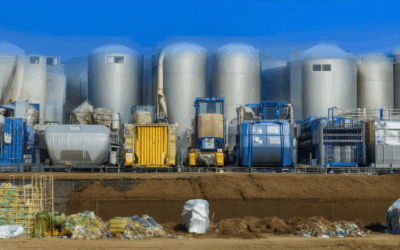As the world increasingly prioritizes sustainability, innovative solutions like green waste-to-energy practices are emerging as pivotal strategies to address environmental challenges while promoting economic growth. These practices not only transform waste into valuable resources but also align with global sustainability goals, offering a cleaner and more efficient alternative to traditional methods. By exploring examples such as advanced technologies in Germany and examining their economic, environmental, and social benefits, this article delves into why green waste-to-energy practices are becoming essential for fostering a more sustainable future. From reducing landfill dependency to enhancing community engagement, these practices present a holistic approach to waste management that deserves closer scrutiny.
Key Takeaways
- Reduction of landfill dependency and methane emissions, promoting resource conservation and a circular economy.
- Significant carbon emissions reduction and a reliable source of renewable energy, aiding climate change mitigation.
- Supports the circular economy by extending material lifecycles and reducing waste.
- Dual benefits of generating renewable energy while minimizing environmental impact.
- Economic benefits including job creation, cost savings, and access to tax incentives and subsidies.
- Contribution to global sustainability goals by combating climate change and promoting sustainable development.
- Improvement in air quality and enhanced soil fertility through biochar production and agricultural applications.
- A triple win for environment, economy, and society, driving innovation and fostering a sustainable future.

Examples of Green Waste-to-Energy Practices
- Anaerobic Digestion: Converts organic waste into biogas, a renewable energy source.
- Gasification: Turns non-recyclable waste into syngas, which can be used for heat or electricity generation.
- Pyrolysis: Breaks down waste at high temperatures to produce biochar and other valuable materials.
These practices reduce landfill dependency and contribute to a sustainable energy future.
City and Company Initiatives
- San Francisco, CA: Implements city-wide composting programs that divert organic waste from landfills and produce biogas.
- Amsterdam, Netherlands: Collects organic waste separately and processes it through anaerobic digestion facilities.
- Covanta Energy: Utilizes advanced gasification technology to convert municipal solid waste into electricity and steam.
Benefits of Green Waste-to-Energy
- Reduces methane emissions from landfills.
- Creates renewable energy resources.
- Supports a circular economy by minimizing waste and maximizing resource recovery.
- Can generate jobs in local communities through waste processing facilities.
These practices demonstrate effective ways to integrate waste management with energy production, promoting sustainability and environmental protection.
Advantages of Green Waste-to-Energy Practices
Green waste-to-energy practices offer numerous benefits over traditional methods, providing a more sustainable and efficient solution for managing organic waste.
- Reduction in Landfill Use: By diverting organic waste from landfills, green practices significantly reduce the volume of waste sent to landfills, helping to preserve natural resources and prevent environmental degradation.
- Lower Greenhouse Gas Emissions: Unlike traditional methods, green waste-to-energy reduces methane emissions, a potent greenhouse gas produced as organic waste decomposes in landfills.
- Resource Efficiency: These practices recover valuable resources such as biogas, which can be converted into renewable energy, reducing reliance on fossil fuels and enhancing overall resource efficiency.
- Renewable Energy Production: Green waste-to-energy systems generate renewable energy, contributing to a cleaner energy portfolio and supporting sustainable development goals.
- Economic Benefits: Diverting waste from landfills can reduce long-term costs associated with waste management, while also creating jobs in the emerging waste-to-energy sector.
- Public Health Improvements: By reducing waste in landfills, green practices can minimize pest infestations, rodent problems, and disease spread, enhancing community well-being.
- Scalability: Green waste-to-energy systems can be adapted to various settings, from urban areas to rural communities, making them a versatile solution for different regions.
Traditional methods of waste management often involve sending organic waste to landfills, which can lead to environmental degradation and resource depletion. In contrast, green practices offer a more sustainable alternative by converting waste into a valuable resource, promoting a circular economy and aligning with global sustainability goals.

Environmental Benefits of Green Waste-to-Energy Practices
Green waste-to-energy practices offer numerous environmental benefits, contributing significantly to sustainability and ecological health. Here are the key advantages:
- Reduction of Landfill Waste: Diverting organic waste from landfills prevents methane emissions, a potent greenhouse gas.
- Renewable Energy Production: Converts organic waste into biogas and biochar, providing a sustainable energy source and improving soil fertility.
- Job Creation: Supports local employment opportunities in facility operations and supply chains, boosting regional economies.
- Resource Recovery: Extracts valuable materials like metals and nutrients, enhancing recycling rates and conserving natural resources.
- Climate Change Mitigation: Reduces methane and CO2 emissions, aiding global efforts to combat climate change.
- Water Conservation: Recovers water from waste, minimizing pollution and reducing the need for freshwater usage in industrial processes.
Examples of successful implementation include city-wide programs in places like San Francisco, demonstrating scalability and effectiveness. To learn more about sustainable living and eco-friendly technologies, visit our sustainable living section or explore our eco-technology page .

Why Green Waste-to-Energy Practices Are Important
Green waste-to-energy practices are essential for promoting sustainability, reducing environmental impact, and fostering a circular economy. Here’s a breakdown of their significance:
- Reduction of Landfill Dependency: Converting organic waste into energy helps decrease the reliance on landfills, which are major contributors to methane emissions and environmental degradation.
- Carbon Emissions Reduction: Generating renewable energy from waste reduces the need for fossil fuels, thereby lowering carbon dioxide emissions and aiding in climate change mitigation.
- Resource Conservation: By transforming waste into energy, we preserve natural resources and minimize the environmental footprint associated with conventional waste disposal methods.
- Support for Circular Economy: Green waste-to-energy practices align with the circular economy by extending the lifecycle of materials and reducing waste.
- Renewable Energy Source: It provides a sustainable source of energy, complementing traditional energy systems and moving towards a low-carbon future.
- Economic Benefits: The sector creates jobs and offers cost savings for municipalities by reducing landfill usage and generating energy, which can offset implementation costs.
- Global Sustainability Goals: It supports international efforts to combat climate change and promote sustainable development, as outlined in global agreements and initiatives.
By adopting green waste-to-energy practices, communities can significantly contribute to a healthier planet and a more sustainable future. Pyrolysium advocates for innovative solutions like pyrolysis to maximize waste potential and promote eco-friendly technologies that drive positive change.
Economic Benefits of Green Waste-to-Energy Practices
Green waste-to-energy practices offer numerous economic benefits that make them appealing to both individuals and communities. Here’s a breakdown of the key advantages:
- Cost Savings:** Reducing landfill dependency lowers long-term operational costs for municipalities and businesses. Energy generation from waste can decrease reliance on expensive fossil fuels.
- Job Creation:** The establishment of waste-to-energy facilities creates employment opportunities across various sectors, including engineering, operations, and maintenance.
- Revenue Generation:** Biogas produced from waste can be sold to power grids or used in vehicles, providing a sustainable revenue stream. Additionally, biochar derived from pyrolysis can be marketed as a high-value soil amendment.
- Reduced Landfill Fees:** Communities that implement green waste programs often see lower landfill costs, as less waste needs to be disposed of conventionally.
- Tax Incentives and Subsidies:** Many governments offer financial incentives to promote waste-to-energy initiatives, reducing the initial investment burden.
- Market Development:** The growth of the waste-to-energy sector fosters innovation and creates new industries, driving economic development in regions where such facilities are established.
By adopting green waste-to-energy practices, communities can achieve a win-win scenario where environmental sustainability meets economic profitability. These practices not only address waste management challenges but also pave the way for future industrial growth and resource efficiency.

Primary Advantages of Implementing Green Waste-to-Energy Practices
Green waste-to-energy practices offer numerous benefits that contribute to environmental sustainability, economic growth, and community well-being. Here are the key advantages:
- Reduces Landfill Dependency: By converting organic waste into biogas, green waste-to-energy practices significantly reduce the amount of waste sent to landfills. This minimizes methane emissions, a potent greenhouse gas, and frees up landfill space.
- Generates Renewable Energy: The biogas produced from waste-to-energy processes can be converted into electricity or transportation fuel, providing a reliable source of renewable energy. This reduces reliance on fossil fuels and supports sustainable energy needs.
- Supports Circular Economy: Green waste practices encourage recycling and repurposing materials. For instance, biochar derived from pyrolysis can be used as a soil amendment, enhancing agricultural productivity and reducing the need for chemical fertilizers.
- Creats Jobs and Drives Innovation: The establishment of green waste facilities generates employment opportunities in construction, operations, and maintenance roles. It also fosters technological advancements, attracting investment and skilled labor, which contributes to local economies.
- Improves Air Quality: Unlike traditional waste incineration, green methods like anaerobic digestion and pyrolysis capture harmful emissions. This reduces the release of pollutants, including particulate matter and volatile organic compounds, thereby enhancing air quality.
- Enhances Soil Fertility: Products like biochar from waste-to-energy processes improve soil health, increasing fertility and carbon sequestration capacity. This supports agricultural productivity and ecosystem health, contributing to food security and biodiversity.
By adopting green waste-to-energy practices, communities can achieve long-term environmental, economic, and social benefits. To learn more about how Pyrolysium can assist in implementing these practices, explore our resources and solutions at Pyrolysium .




0 Comments